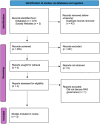Robotic surgery governance structures: a systematic review
- PMID: 40374950
- PMCID: PMC12081519
- DOI: 10.1007/s11701-025-02356-8
Robotic surgery governance structures: a systematic review
Abstract
Since the Food and Drug Administration in the United States approved the first robotic platform for use in humans in 2000, there has been a steady increase in the popularity of robotic approaches to surgery. Robotic-assisted surgery (RAS) offers enhanced 3D visualisation of the operative field and increased flexibility and agility of the instruments, amongst other benefits. However, robotic platforms are complex systems and there is evidence that they may be associated with increased patient risk, particularly in the initial learning curve of a surgeon's robotic training. To ensure the continued safe use of RAS, adequate governance policies must be in place to regulate training, ensure patient safety and maximise the benefits of RAS programs. This systematic review synthesises all available evidence on RAS governance structures internationally for the first time. It was conducted and reported per the Preferred Reporting Items for Systematic Reviews and Meta-Analyses statement. This systematic review identified, for the first time, three guidelines offering recommendations on the Governance Structures for RAS programs. We extracted the key recommendations to provide a holistic set of guidelines. Through consensus, we offer recommendations for the composition of a RAS governance committee, the frequency with which the committee should sit, and the remit of the committee, including training, granting of privileges, quality assurance and continued professional development. We also stress future research needs in RAS team credentialing and vendor-agnostic training pathways. These recommendations may serve as a template for establishing future RAS programs.
Keywords: Governance structures; Privileges; Robotic-assisted surgery; Training.
© 2025. The Author(s).
Conflict of interest statement
Declarations. Competing interest: All authors report that there are no conflicts of interest.
Figures




Similar articles
-
Robotically Assisted Thoracic Surgery: Proposed Guidelines for Privileging and Credentialing.Innovations (Phila). 2016 Nov/Dec;11(6):386-389. doi: 10.1097/IMI.0000000000000320. Innovations (Phila). 2016. PMID: 27922990
-
Are current credentialing requirements for robotic surgery adequate to ensure surgeon proficiency?Surg Endosc. 2021 May;35(5):2104-2109. doi: 10.1007/s00464-020-07608-2. Epub 2020 May 6. Surg Endosc. 2021. PMID: 32377839
-
Training in robotic surgery: simulators, surgery, and credentialing.Urol Clin North Am. 2014 Nov;41(4):581-9. doi: 10.1016/j.ucl.2014.07.012. Epub 2014 Aug 22. Urol Clin North Am. 2014. PMID: 25306169 Review.
-
Robotic Thoracic Surgery Training for Residency Programs: A Position Paper for an Educational Curriculum.Innovations (Phila). 2018 Nov/Dec;13(6):417-422. doi: 10.1097/IMI.0000000000000573. Innovations (Phila). 2018. PMID: 30516571
-
A review of robotic surgical training: establishing a curriculum and credentialing process in ophthalmology.Eye (Lond). 2021 Dec;35(12):3192-3201. doi: 10.1038/s41433-021-01599-7. Epub 2021 Jun 11. Eye (Lond). 2021. PMID: 34117390 Free PMC article. Review.
References
-
- Bodner J, Augustin F, Wykypiel H, Fish J, Muehlmann G, Wetscher G et al (2005) The da Vinci robotic system for general surgical applications: a critical interim appraisal. Swiss Med Wkly 135(4546):674 - PubMed
-
- Harji D, Houston F, Burke J, Griffiths B, Tilney H, Miskovic D et al (2023) The current status of robotic colorectal surgery training programmes. J Robot Surg 17(2):251–63 - PubMed
-
- Halabi WJ, Kang CY, Jafari MD, Nguyen VQ, Carmichael JC, Mills S et al (2013) Robotic-assisted colorectal surgery in the United States: a nationwide analysis of trends and outcomes. W J Surg 37:2782–90 - PubMed
Publication types
MeSH terms
LinkOut - more resources
Full Text Sources

